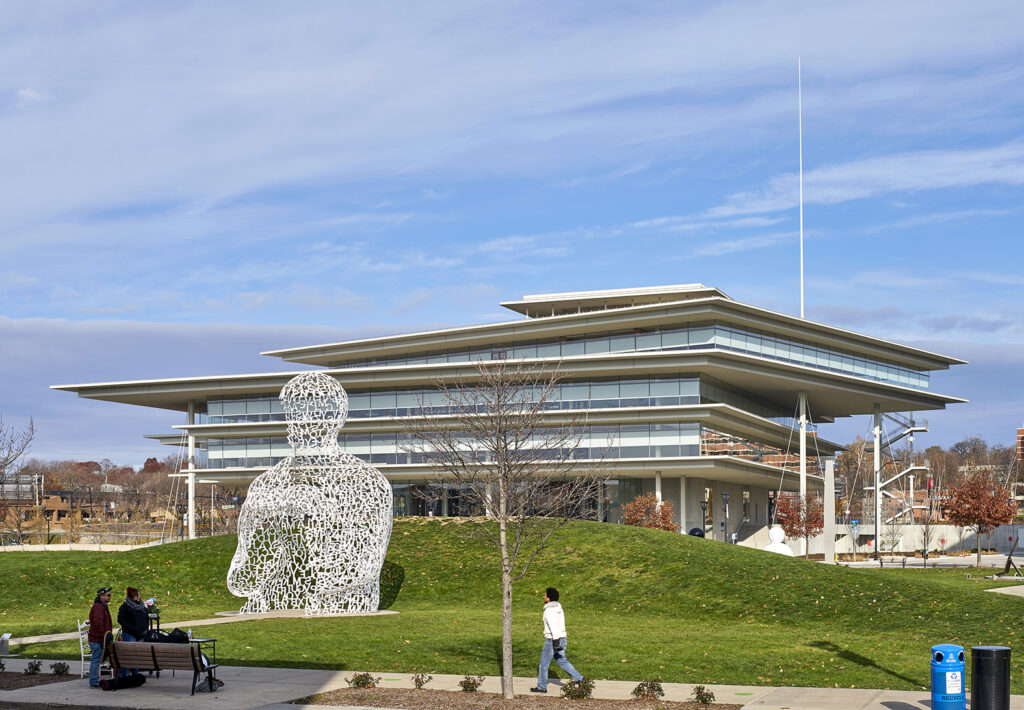Energy secretary visits Ames National Laboratory

Gigi Wood Aug 15, 2025 | 10:52 am
4 min read time
887 wordsAll Latest News, Education, Innovation and Entrepreneurship
U.S. Secretary of Energy Chris Wright spent most of Thursday touring the Ames National Laboratory on the Iowa State University campus. It was the 12th of 17 national laboratories Wright has visited this year.
The Ames National Laboratory uses research, technologies and partnerships to solve global problems, such as energy production.
“Our mission at the Ames National Laboratory is to deliver critical material solutions to the nation,” said Karl Mueller, director of the Ames National Laboratory. “We do that by controlling things like the motion of atoms and the motion of energy through systems. We do it through innovating for science and for industry, and we translate our fundamental discoveries into new technologies.”
Wright, a self-described “energy geek” said the Ames lab is a leading materials science laboratory. The U.S. needs to produce more of the materials used in energy production, instead of outsourcing them, and the Ames lab can help in that effort, he said.
The Ames lab “is leading today in so many of the developments of new materials, reshoring dependencies from overseas and innovating new materials that are going to help bring fusion energy, a new commercial energy source, going to bring all sorts of medical advancements and technologies. But these things require advanced materials, that requires chemistry, that requires processes and that requires scientists ceaselessly working on these problems,” Wright said.
Wright said he is interested in continuing to fund the Ames lab. Research is a necessary cost, he said.
“A laboratory is a resource for next-generation energy production technology, next-generation materials, next-generation national security interests. Those are different,” Wright said. “And of course, when I got [to the Department of Energy], the original idea was, ‘Let’s cut everything. Let’s shrink everything. We need to shrink our spending of the government.’ But the smallest, and potentially no cuts, will be to the broader national laboratory complex. These are investments in our future. They’re much smaller dollars than giant corporate subsidies, and they have huge payoffs.”
According to a prepared statement from the Department of Energy on Thursday, the Trump administration’s fiscal year 2026 budget proposal includes $47.4 million for the Ames National Laboratory, with funding from the Office of Science, the Office of Energy Efficiency and Renewable Energy, and the Office of Fossil Energy and Carbon Management.
The funding is a 4% decrease from the fiscal year 2025 enacted level, but is a 17% increase from fiscal year 2024. Additional resources may be awarded through competitive lab proposals during the execution year, the statement said.
Wright said he expects more output from national laboratories.
“We’re looking for efficiencies and improvement, but we want to see meaningfully more throughput in our national labs during the next four years of the Trump administration than during the last four years of the Biden administration, where a lot of the money was spent on politically popular things, things that sounded good and feel good to some people, but weren’t basic science,” Wright said.
The energy department plans to spend less money on corporate subsidies, he added.
“The fundamental problem of our government is we collect $1 in taxes and we spend $1.35. Think if you ran your household budget that way, that’s just not a sustainable trajectory,” Wright said. “Absolutely, one of the priorities when we came in is, what is money the government spends that it could spend more efficiently or that it shouldn’t spend on? The biggest thing we’ve looked at through energy is energy subsidies, which is basically money to corporations.”
Green energy tax credits for solar and wind are no longer needed because those are now established industries, he said.
“Are we still investing in next generation solar technologies and batteries? Absolutely, but we need to get nuclear energy going again,” Wright said. “We have next generation geothermal arriving now. We have to stabilize our electricity grid. We need to get away from the nonsense that somehow we’re not going to use fossil fuels in the near future.”
Wright said the “One Big, Beautiful Bill” will reduce restrictions on energy production in the U.S. Energy production is a major focal point of the legislation, with the goal of creating energy independence through offshore and onshore oil and gas development, coal, water infrastructure and hydropower and timber production.
“It took some shackles off permitting that allowed us to build facilities to do innovation,” Wright said. “Funding toward making America strong, toward lowering our costs and making our economy prosperous and making us less dependent on, sometimes [countries that are] not our friends abroad that we depend on for critical materials.”
U.S. Sen. Joni Ernst said the materials researched at the Ames lab could be used in the military.
“I have a particular interest in those critical materials as they benefit our defense industrial base and the development of new platforms and technologies which will make sure that our military stays strong, essentially then keeping our great United States of America safe,” Ernst said.
On Wednesday, the Department of Energy announced $1 billion in funding opportunities to advance scale mining also known as small-scale mining and processing and manufacturing technologies across critical minerals and materials supply chains.

Gigi Wood
Gigi Wood is a senior staff writer at Business Record. She covers economic development, government policy and law, agriculture, energy, and manufacturing.










